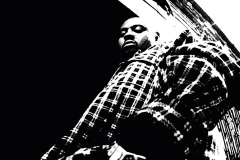A couple of years ago, our own Jonathan Shipley took a stab at writing a city profile on Buffalo, NY. Buffalo, NY? Yeah, Buffalo, NY. So this is a throwback to a different time, when things were slower and life was, well, just as difficult as it is now. It was only a couple of years ago after all. But Buffalo, the city named after the American Buffalo, had quietly built a reputation of its own in music. Jonathan spoke with a few individuals that help it thrive culturally.
Chelsea O, a DJ in Buffalo, New York, asked, “Buffalo. I mean, that’s cool, but why Buffalo?” Why Buffalo, indeed. What does one outside of Buffalo know about Buffalo? There are the Buffalo Bills—the much-maligned football team. High school history textbooks tell us that President McKinley got assassinated in Buffalo. Ummm… what else? It’s cold and has snowy winters, I think.
But there’s much more to Buffalo than common laypeople realize! Its music scene, for one thing. “Wait a minute—Buffalo has a music scene?” you scoff. I understand. All we know of Buffalo is almost nothing at all. But, it’s true, music emanates from the City of Good Neighbors. With deep roots in classical music and jazz, Buffalo’s also seen the rise of such varied acts as Spyro Gyra, Ani DiFranco, Rick James, Vincent Gallo and the Goo Goo Dolls.
Three people who know something about Buffalo’s music scene are the aforementioned Chelsea O, a weekend disc jockey for Alternative Buffalo 107.7 (and a musician in her own right for the band Wolf); Jeff Miers, music writer of the Buffalo News since 2002; and Leonard Silver, founder, and owner of the fabled record store Record Theatre.
ALTERNATIVE BUFFALO’S CHELSEA O
“My dad controlled the car stereo,” says Chelsea O, a 25-year-old DJ for Alternative Buffalo. “I was listening to Neil Young, Tom Petty and the Heartbreakers, The Doors, The Rolling Stones and The Beatles.” When they weren’t traveling in the car, her dad was at home strumming on the guitar. There was always music in the house. She grew up on the oldies. Her favorite station at the time was Oldies 104.1. She liked the Jackson Five quite a bit. This was until middle school when one begins to discover music on one’s own when one develops their own tastes and sensibilities. “I became obsessed with Avril Lavigne.” Chelsea shifted gears from the oldies to the now. Pop punk was her bag. Sum 41, Blink-182, Green Day and Fall Out Boy became her jams.
“Though a lot of people mock those bands, it was reading interviews with them that I discovered their influences and started listening to those bands,” Chelsea states. Enter Nirvana. Enter The Replacements. Elliot Smith. Radiohead made it over her speakers. In college, she began thinking, “Maybe I can make
music my career somehow. Maybe not a musician, per se, but something that could get me a job in ‘the real world.’” She got a degree in Communication in hopes of being a radio personality one day. She got a job at a radio station, but only as a board operator. She moved up the ranks—fill-in radio jock, producer. She’s now on weekends and is the host of the local music show “Localized.” “One of the cool things about the Buffalo music scene is that it’s incredibly diverse,” she says. She would know.
“It comes in a wide array of genres, including folk, singer/songwriter, blues, jazz, indie, rock, and hip-hop.” Some of her favorite local bands? The alt-rock band The Naturalists. “They recently released a killer EP called Home Honey, I’m Home.” Steak & Cake Records records local acts, but its founder, Brandon Schlia, releases his own material and that of a band he’s in, Red Heat. Chelsea also likes Grace Stumberg, who, in turn, is a guitar tech for the one and only Joan Baez. Another Grace, Lougen, “shreds on guitar,” enthuses Chelsea. “Those are just to name a few!” Chelsea O continues to find Buffalo talent, whether at work or just driving around town, Sleater-Kinney music blasting through the speakers. “I just knew I wanted to be involved with music in my day-to-day life.” Mission accomplished.
THE BUFFALO NEWS’ JEFF MIERS
Jeff Miers, as a kid, demanded his mother play Joan Baez’s 2-volume Joan Baez in Concert on the
turntable all the time. Baez, and Simon and Garfunkel. That, or Miles Davis’ greatest hits. “The first
track was ‘Seven Steps to Heaven,’” Miers recalls. “I absolutely loved it, in the way that toddlers love
something. It made me smile and laugh. I thought it was awesome.” It was Miles Davis and The Beatles who turned the 48-year-old music critic onto music. “They remain huge to me to this day.” Every penny he saved—chores, birthday gift money—he’d spend on Beatles records. Abbey Road was the first. “I was obsessed with music by age ten.” Music is an ever-evolving gateway. Listen to one band and that band leads you to another band. That band to another band. The music app Pandora obviously knows this all too well. Soon, a symphony of musicians can be coloring your entire life. For Miers, The Beatles led to The Rolling Stones. The Stones led to 70s greats like SteelyDan, Aerosmith, Queen, Return to Forever and Mahavishnu Orchestra. The more Miers listened to music, the more he wanted to listen to more
music. The more people he listened to, the bigger that colorful symphony got.
“The common denominator in all this music,” he says, “was the way it reached me in an emotional
and visceral level first, and then an intellectual one later.” The music, to him, was, and is, significant and profound, able to transport people from the humdrum. How did this love of music translate into his
writing? There were books everywhere in the house when he was a kid. “I read Albert Camus’ A Happy Death at age ten. That was a bit premature!” Once he couldn’t deny his growing obsession with music, he read about it, thumbing through countless copies of magazines like Creem, Hit Parader, Circus and Rolling Stone. “All the while, I was learning to play guitar on my own,” he says. “I started to see a really deep connection between writing about music and playing music—in terms of narrative development. Playing music and writing about music was always part of the same thing to me.”
Playing in alt bands in the 1990s, he got to Buffalo by way of grad school at the University of Buffalo. He started doing freelance music writing for alt-weeklies. He started his own zine. He became the all-around music writer guy for Buffalo. Buffalo News offered him a job near the end of 2001. Since then, he’s come to know quite a bit about Buffalo’s music scene. “Music brought me to Buffalo, and music convinced me to stay here and make it home.” It’s not just his home, of course. It’s home to all sorts of music being constantly created by all sorts of musicians. The near-recent shifting economics have pulled Buffalo’s musicians away, but things are starting to turn around. 20-somethings are reentering the scene. “Diversity remains the key,” Miers says. “You won’t get rich here, but you’ll find plenty of work and an avid audience.” Some bands and artists he’s smitten with of late: Aqueous, Funktional Flow, The Sleepy Ha Has, Super Killer Robots and Wooden Wares. “I could go on like this all day,” he says. He could. He wants to. Buffalo music is pumping in his blood.
RECORD THEATRES’ LEONARD SILVER
The year was 1976. Leonard Silver had 20 years of music industry experience already behind him when he opened Record Theatre, billed as “the largest record store in the world.” At the time, Silver had been president and founder of Transcontinent Record Sales, which had developed many divisions, including label distribution, rack merchandising, a record label, a retail sector, onestops and music publishing. Having a hand in every aspect of the record industry, he knew how to make a record store in Buffalo work. Make it a trendsetter, stock it full and attract music lovers of all genres. The 1970s and 80s proved successful for Silver. The retail chain grew to over 15 stores, including record shops in Philadelphia, Baltimore, Cincinnati, Cleveland and more. CDs came. Big-box retailers came. Discount stores came.
Many of the retail outlets had to shutter. Silver was committed, though. He kept his Western New York stores open as smaller operations. He focused on a deeper catalog and finding niche audiences, those
that wanted imports and indie titles. The big-box retailers were eager for the tried and true Billboard
hits. Silver looked elsewhere to find his audience. It proved successful. “By staying true to our non-corporate image, hiring a knowledgeable staff and focusing on maintaining great product, Record Theatre preserved its warm, welcoming record store reputation,” notes Kelly Mordaunt, a close associate of Silver’s.
The vinyl craze has been a boon for the retailer. Since the 1990s, vinyl records have been all the rage with music fans. Mordaunt continues, “The music-hungry Buffalo populace continues to demand the best service and selection possible.” Only two Record Theatre locations remain (the other is in Amherst, New York). They retain their mom-and-pop feel. They cater to record collectors, and throughout the decade sales have increased. What’s next for Silver? Bringing Buffalonians what they want—good music.









Social Media